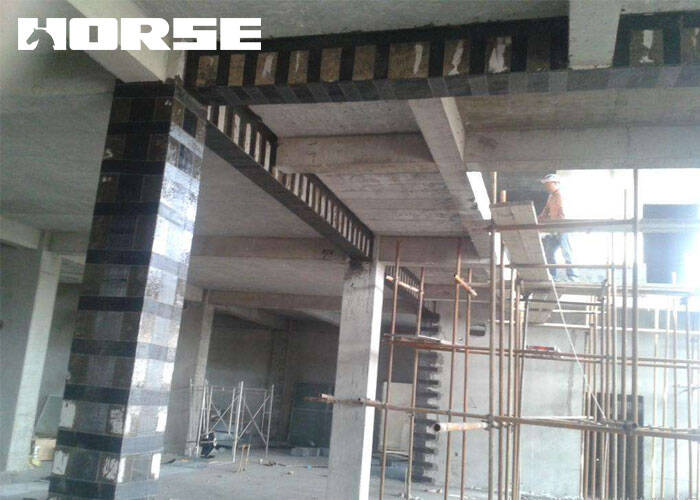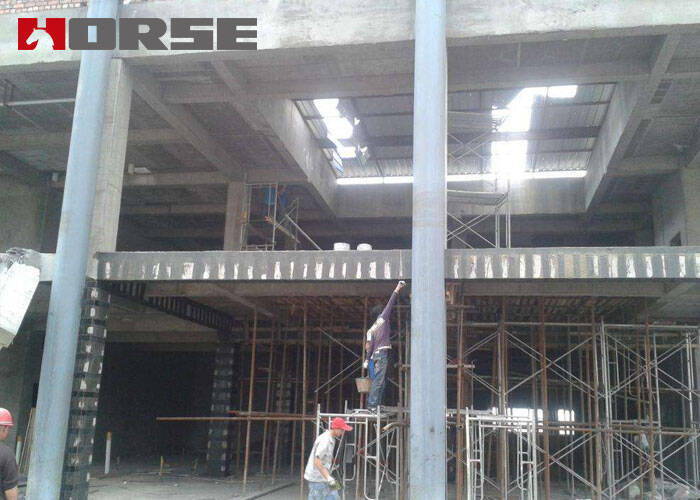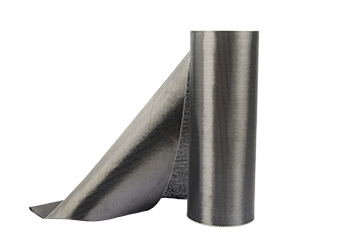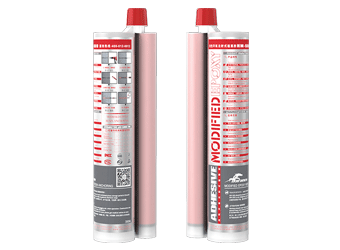Solutions
Horse Construction offers full range of structural strengthening materials with technical supports, documentation supports, products supports, project supports.
carbon fiber for columns

1. The development of FRP composite reinforcement method
Fiber-reinforced composite materials have proven their own advantages through many years of engineering practice and scientific research: light weight, high strength, and corrosion resistance, and they have been widely recognized and used. FRP includes: CFRP (carbon fiber), GFRP (glass fiber), AFRP (aramid fiber), BFRP (basalt fiber). After the concrete column is reinforced by FRP, the lateral deformation of the concrete is obviously reduced, and the ultimate compressive strength and ductility of the concrete column are greatly improved.
2. Properties of FRP composites
2.1 The physical properties of FRP
The density of FRP ranges from 1.25 to 2Bg/cm3, which is 1/6 to 1/4 of steel. Low density can reduce weight and facilitate transportation and installation. FRP should not be used in high temperature structures. The softening temperature of FRP is called "Grass Transition Temperature Tg", which mainly depends on the type of resin, usually 65~122°C. When the temperature exceeds Tg, the elastic modulus of FRP will be greatly reduced.
2.2 Mechanical properties
As we all know, the main force direction of FRP is the direction mainly parallel to the fiber, which is the axial direction. Tensile strength, compressive strength and bonding properties are the main mechanical properties of FRP.
2.2.1 tensile strength
Fiber is the basis of FRP tensile strength, and resin mainly plays a certain auxiliary role. The stress-strain curve of fiber, resin and FRP. The stress-strain relationship of FRP is linear elastic relationship. The ultimate strength of fiber is higher than that of FRP. The ultimate tensile strain of the resin is higher than the ultimate tensile strain of FRP and fiber, which indicates that the resin breaks after the fiber breaks.
2.2.2 Compressive strength
The compressive strength of FRP is lower than the tensile strength. The compressive strengths of GFRP, CFRP, and AFRP are 55%, 78%, and 22% of the tensile strength, respectively. In most cases, the compressive strength of FRP is proportional to the tensile strength of FRP.
2.2.3 Bonding performance
The service performance and bearing capacity of the structure are affected by the bonding performance, and the FRP form, material properties, geometric dimensions and FRP surface shape can all affect the bonding performance.
2.3 Long-term performance
① Creep fracture
The creep fracture of FRP is the sudden fracture of FRP under long-term constant load. And the endurance time of FRP gradually decreases with the increase of the load duration.
②Fatigue performance
FRP has good fatigue resistance when the fiber and resin are well bonded, and it is less affected by external factors.
③Durability
The test results show that CFRP exhibits good durability; GFRP has good acid resistance and freeze-thaw cycle performance; AFRP also has good durability.

The significance of CFRP wrap and CFRP laminate strips in retrofit concrete columns
Whether it is a building or a structure, the most important load-bearing component of a building structure is the column structure, and the reliability and comfort of the building are closely related to it. Reinforced concrete columns are currently the most used column structure in the main structure of buildings and structures in my country.
CFRP wrapping concrete columns can effectively improve the axial compressive bearing capacity of the columns. The use of CFRP can significantly increase the compressive strength of concrete and improve the ductility of concrete. At the same time, for concrete structure reinforcement and reconstruction projects, CFRP reinforced concrete column technology has many advantages (high strength and light weight, durability, ease of construction, etc.). The reinforcement method of CFRP reinforced concrete columns has been applied in more and more practical projects.
In projects where carbon fiber cloth is used for reinforcement and reconstruction, due to cost and construction considerations, many structures are currently reinforced with carbon fiber plates. In many practical projects, the method of reforming and retrofit carbon fiber plates is also used, and it has also been proved to improve the bearing capacity and ductility of structural members. The use of carbon fiber plates for reinforcement can effectively increase the utilization rate of carbon fiber and has good economic benefits. Especially in terms of construction, the use of carbon fiber plates reinforcement requires little construction site and construction space, which can effectively and flexibly organize construction
You can find anything here you are in need of, have a trust trying on these products, you will find the big difference after that.

High strength, unidirectional carbon fiber fabric pre-saturated to form a carbon fiber reinforced polymer (CFRP) fabric used to strengthen structural concrete elements.

High strength, unidirectional carbon fiber sheet pre-saturated to form a carbon fiber reinforced polymer (CFRP) sheet used to strengthen structural concrete elements.

Two-components modified epoxy resin adhesive, with high quality plastic tube, double cartridge package for anchoring